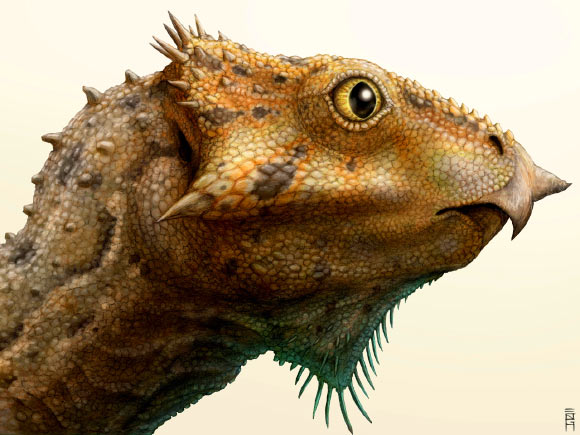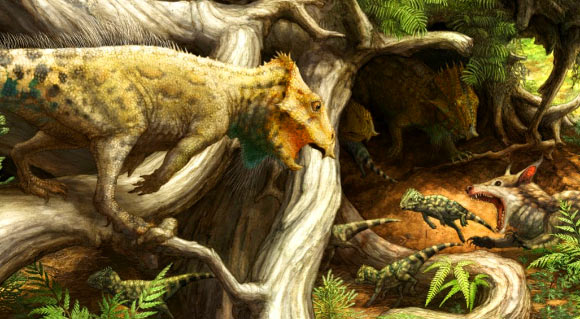A group of paleontologists led by Dr Andrew Farke from Raymond M. Alf Museum of Paleontology has described a new genus and species of ceratopsian dinosaur that lived in what is now southern Montana during the Early Cretaceous epoch, about 108 million years ago.

Life restoration of Aquilops americanus. Image credit: Brian Engh / Raymond M. Alf Museum of Paleontology.
The new dinosaur belongs to a group of herbivorous, beaked dinosaurs called Ceratopsia, better known as horned dinosaurs. Unlike its famous relatives, such as Triceratops, it lacked horns and a bony neck frill.
It is named Aquilops americanus, meaning American eagle face.
The genus name refers to the hook-like beak at the front of the skull, used to snip plants during feeding.
Aquilops americanus was about the size of a small cat, weighing around 1.6 kg and measuring around 60 cm in total length.
It is the oldest species of horned dinosaur known from North America, about 40 million years older than the iconic horned dinosaur Triceratops, which weighed up to 4,000 times more.
“This dinosaur lived nearly 20 million years before the North America’s oldest previously known horned dinosaur,” said Dr Farke, who is the lead author of the paper published in the journal PLoS ONE.

Reconstruction of Aquilops americanus in its environment. Image credit: Brian Engh / Raymond M. Alf Museum of Paleontology.
Aquilops americanus’ partial skull and lower jaw were uncovered from the Cloverly Formation in Montana in 1997.
“The skull is comparatively small, measuring 8.4 cm long, and is distinguished by several features, including a strongly hooked rostral bone and an elongated and sharply pointed cavity over the cheek region,” Dr Farke said.
He added: “Aquilops americanus is the first fossil to show what the earliest horned dinosaurs in North America looked like.”
Surprisingly, the new dinosaur turns out to be more closely related to ceratopsians from Asia than to other ceratopsians from North America.
“We were surprised that it was more closely related to Asian animals than those from North America,” Dr Farke said.
This is consistent with evidence from other animals, including carnivorous dinosaurs as well as early mammals, showing an immigration of species from Asia into North America sometime between 115 and 105 million years ago.
Aquilops americanus will be stored in the vertebrate paleontology collection at the Sam Noble Oklahoma Museum of Natural History in Norman, Oklahoma.
_____
Farke AA et al. 2014. A Ceratopsian Dinosaur from the Lower Cretaceous of Western North America, and the Biogeography of Neoceratopsia. PLoS ONE 9 (12): e112055; doi: 10.1371/journal.pone.0112055







